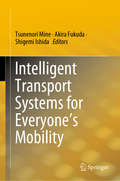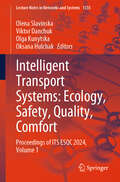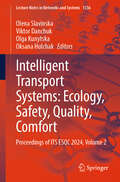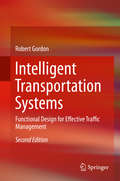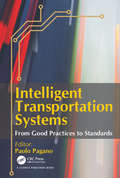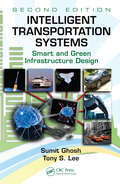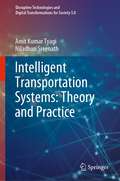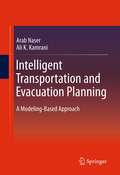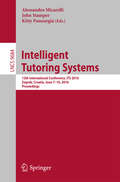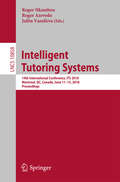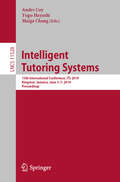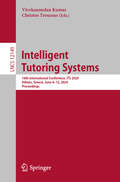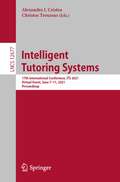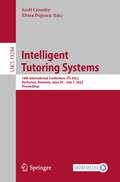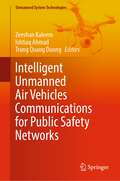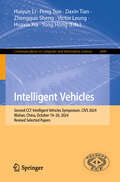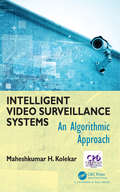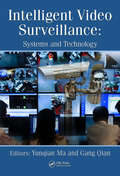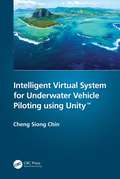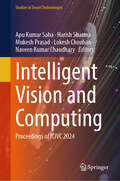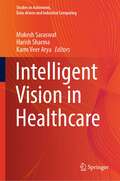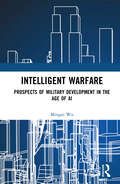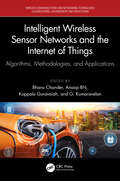- Table View
- List View
Intelligent Transport Systems for Everyone’s Mobility
by Tsunenori Mine Akira Fukuda Shigemi IshidaThis book presents the latest, most interesting research efforts regarding Intelligent Transport System (ITS) technologies, from theory to practice. The book’s main theme is “Mobility for everyone by ITS”; accordingly, it gathers a range of contributions on human-centered factors in the use or development of ITS technologies, infrastructures, and applications. Each of these contributions proposes a novel method for ITS and discusses the method on the basis of case studies conducted in the Asia-Pacific region.The book are roughly divided into four general categories: 1) Safe and Secure Society, 2) ITS-Based Smart Mobility, 3) Next-Generation Mobility, and 4) Infrastructure Technologies for Practical ITS. In these categories, several key topics are touched on with each other such as driver assistance and behavior analysis, traffic accident and congestion management, vehicle flow management at large events, automated or self-driving vehicles, V2X technologies, next-generation public transportation systems, and intelligent transportation systems made possible by big data analysis. In addition, important current and future ITS-related problems are discussed, taking into account many case studies that have been conducted in this regard.
Intelligent Transport Systems: Proceedings of ITS ESQC 2024, Volume 1 (Lecture Notes in Networks and Systems #1335)
by Olena Slavinska Viktor Danchuk Olga Kunytska Oksana HulchakThis book contains selected articles on the topics of "Smart Cities and Sustainable Development" and "Intelligent Transport Technologies and Smart Logistics," which will be of interest to academics, researchers, and industry representatives to familiarize themselves with advanced experiences, research results, and best practices in the field of ITS. The 2nd International Scientific Conference ITS ESQC was held on November 26–27, 2024, Kyiv, Ukraine. The National Transport University organized the conference with the Ministry of Education and Science of Ukraine. 119 papers were submitted through the Microsoft CMT platform, of which 76 were accepted from 44 universities from countries such as Ukraine, Poland, the Philippines, England, Italy, Brazil, Spain, and Lithuania. All submitted papers were assessed for compliance with the requirements of www.itsesqc.ntu.edu.ua and reviewed by reviewers, including scientists from Europe and Ukraine.
Intelligent Transport Systems: Proceedings of ITS ESQC 2024, Volume 2 (Lecture Notes in Networks and Systems #1336)
by Olena Slavinska Viktor Danchuk Olga Kunytska Oksana HulchakThe 2nd International Scientific Conference ITS ESQC was held on November 26–27, 2024, Kyiv, Ukraine. The National Transport University organized the conference with the Ministry of Education and Science of Ukraine. This book contains selected articles on the topics of "Smart Mobility and Road Safety,&” "Infrastructure of ITS and Construction," and "ITS Development in the Post-War Recovery of the Country," which will be of interest to academics, researchers, and industry representatives to familiarize themselves with advanced experiences, research results, and best practices in the field of ITS. 119 papers were submitted through the Microsoft CMT platform, of which 76 were accepted from 44 universities from countries such as Ukraine, Poland, the Philippines, England, Italy, Brazil, Spain, and Lithuania. All submitted papers were assessed for compliance with the requirements of www.itsesqc.ntu.edu.ua and reviewed by reviewers, including scientists from Europe and Ukraine.
Intelligent Transportation System and Advanced Technology (Energy, Environment, and Sustainability)
by Vikram Kumar Ram Krishna Upadhyay Sunil Kumar SharmaThis book explores the recent advancements in intelligent transportation sector. In today's rapidly evolving world, transportation plays a pivotal role in shaping our societies and economies. As the demands on our transportation systems continue to grow, there is an increasing need for innovative solutions to enhance efficiency, safety, and sustainability. This book provides a comprehensive and up-to-date exploration of the intersection between transportation and cutting-edge technology. It offers a thorough examination of the various facets of Intelligent Transportation Systems (ITS) and advanced technologies applied to the transportation sector. It analyzes the latest trends, technologies, and developments that are shaping the future of transportation, including AI, IoT, and smart infrastructure. It provides practical insights, case studies, and real-world examples to help transportation professionals and researchers understand how advanced technology can be applied to address transportation challenges. It discusses the policy and regulatory considerations surrounding the implementation of advanced transportation technologies and explores the potential future developments and advancements in the field, including the impact of emerging technologies.
Intelligent Transportation Systems
by Robert GordonIntelligent Transportation Systems: Functional Design for Economical and Efficient Traffic Management provides practical guidance on the efficient use of resources in the design of ITS. The author explains how functional design alternatives can meet project objectives and requirements with optimal cost effectiveness and clarifies how transportation planning and traffic diversion principles relate to functional ITS device selections and equipment locations. Methodologies for translating objectives to functional device types, determining device deployment densities and determining the best placement of CCTV cameras and message signs are provided, as are models for evaluating the benefits of design alternatives based on traffic conditions. Readers will learn how to reduce recurrent congestion, improve incident clearance time in non-recurrent congestion, provide real-time incident information to motorists, and leverage transportation management center data for lane control through important new active transportation and demand management (ATDM) methods. Finally, the author examines exciting developments in connected vehicle technologies, exploring their potential to greatly improve safety, mobility and energy efficiency. This resource will greatly benefit all ITS designers and managers and is of pivotal importance for operating agencies performing evaluations to justify operational funding and system expansions.
Intelligent Transportation Systems: From Good Practices to Standards
by Paolo PaganoIntelligent Transport Systems (ITS) are the way forward for sustainable growth of mobility at all levels (local, regional, national, transnational). The book reviews the current status of Research & Development. It includes connected (and autonomous) cars and buses, real-world large-scale field trials, data analysis and assessment of technological solutions. Standards and normative aspects in the domain of Electronic Fee Collection and Cooperative Systems oriented to probe data collection, safety and non-safety critical applications in vehicular networks, are studied. The book provides the rational, perspectives, and technical issues for the implementation of ITS solutions in a genuine inter-modal scenario, taking the example of a Mediterranean seaport, actively involved in testing and validation of ITS standards. The novelty of this book is that it covers R&D, standards, and pilots, all under one cover. Rather than stressing the novelty in ICT, the authors have presented the need for system-level integration, assessment of existing (standard) solutions, and piloting experiments in real-world industrial scenarios.
Intelligent Transportation Systems: Smart and Green Infrastructure Design, Second Edition (Mechanical and Aerospace Engineering Series)
by Sumit Ghosh Tony S. LeeFor many transportation systems, the cost of expanding the infrastructure is too high. Therefore, the focus must shift to improving the quality of transportation within the existing infrastructure. The second edition of a bestseller, Intelligent Transport Systems: Smart and Green Infrastructure Design critically examines the successes and failures
Intelligent Transportation Systems: Theory and Practice (Disruptive Technologies and Digital Transformations for Society 5.0)
by Amit Kumar Tyagi Niladhuri SreenathThis book provides fundamental principles of intelligent transport systems with comprehensive insight and state of the art of vehicles, vehicular technology, connecting vehicles, and intelligent vehicles/autonomous intelligent vehicles. The book discusses different approaches for multiple sensor-based multiple-objects tracking, in addition to blockchain-based solutions for building tamper-proof sensing devices. It introduces various algorithms for security, privacy, and trust for intelligent vehicles. This book countermeasures all the drawbacks and provides useful information to students, researchers, and scientific communities. It contains chapters from national and international experts and will be essential for researchers and advanced students from academia, and industry experts who are working on intelligent transportation systems.
Intelligent Transportation and Evacuation Planning
by Ali K. Kamrani Arab NaserIntelligent Transportation and Evacuation Planning: A Modeling-Based Approach provides a new paradigm for evacuation planning strategies and techniques. Recently, evacuation planning and modeling have increasingly attracted interest among researchers as well as government officials. This interest stems from the recent catastrophic hurricanes and weather-related events that occurred in the southeastern United States (Hurricane Katrina and Rita). The evacuation methods that were in place before and during the hurricanes did not work well and resulted in thousands of deaths. This book offers insights into the methods and techniques that allow for implementing mathematical-based, simulation-based, and integrated optimization and simulation-based engineering approaches for evacuation planning.
Intelligent Tutoring Systems
by Alessandro Micarelli John Stamper Kitty PanourgiaThis book constitutes the refereed proceedings of the 13th International Conference on Intelligent Tutoring Systems, ITS 2016, held in Zagreb, Croatia, in June 2016. The 20 revised full papers, 32 short papers, 35 posters, and 7 young researchers' track papers presented in this volume were carefully reviewed and selected from 147 submissions. The specific theme of the ITS 2016 conference is "Adaptive Learning in Real World Contexts". ITS 2016 covers a wide range of topics such as: intelligent tutoring; informal learning environments, learning as a side effect of interactions; collaborative and group learning, communities of practice and social networks; simulation-based learning and serious games; dialogue and discourse during learning interactions; co-adaptation between technologies and human learning; ubiquitous and mobile learning environments; empirical studies of learning with technologies, understanding human learning on the web; adaptive support for learning, models of learners, diagnosis and feedback; modeling of motivation, metacognition, and affect aspects of learning; recommender systems for learning; virtual pedagogical agents and learning companions; ontological modeling, semantic web technologies and standards for learning; multi-agent and service oriented architectures for learning and tutoring environments; educational exploitation of data mining and machine learning techniques; instructional design principles or design patterns for educational environments; authoring tools and development methodologies for advanced learning technologies; domain-specific learning technologies, e. g. language, mathematics, reading, science, medicine, military, and industry; non conventional interactions between artificial intelligence and human learning; and privacy and security in e-learning environments.
Intelligent Tutoring Systems: 14th International Conference, ITS 2018, Montreal, QC, Canada, June 11–15, 2018, Proceedings (Lecture Notes in Computer Science #10858)
by Roger Azevedo Julita Vassileva Roger NkambouThis book constitutes the proceedings of the 14th International Conference on Intelligent Tutoring Systems, IST 2018, held in Montreal, Canada, in June 2018.The 26 full papers and 22 short papers presented in this volume were carefully reviewed and selected from 120 submissions. In the back matter of the volume 20 poster papers and 6 doctoral consortium papers are included. They deal with the use of advanced computer technologies and interdisciplinary research for enabling, supporting and enhancing human learning.
Intelligent Tutoring Systems: 15th International Conference, ITS 2019, Kingston, Jamaica, June 3–7, 2019, Proceedings (Lecture Notes in Computer Science #11528)
by Maiga Chang Andre Coy Yugo HayashiThis book constitutes the proceedings of the 15th International Conference on Intelligent Tutoring Systems, ITS 2019, held in Kingston, Jamaica, in June 2019. The 14 full papers and 13 short papers presented in this volume were carefully reviewed and selected from 42 submissions. In the back matter of the volume 4 poster papers are included. They deal with the use of advanced computer technologies and interdisciplinary research for enabling, supporting, and enhancing human learning.
Intelligent Tutoring Systems: 16th International Conference, ITS 2020, Athens, Greece, June 8–12, 2020, Proceedings (Lecture Notes in Computer Science #12149)
by Vivekanandan Kumar Christos TroussasThis volume constitutes the proceedings of the 16th International Conference on Intelligent Tutoring Systems, ITS 2020, held in Athens, Greece, in June 2020. The 23 full papers and 31 short papers presented in this volume were carefully reviewed and selected from 85 submissions. They reflect a variety of new techniques, including multimodal affective computing, explainable AI, mixed-compensation multidimensional item response, ensemble deep learning, cohesion network analysis, spiral of silence, conversational agent, semantic web, computer-supported collaborative learning, and social network analysis.
Intelligent Tutoring Systems: 17th International Conference, ITS 2021, Virtual Event, June 7–11, 2021, Proceedings (Lecture Notes in Computer Science #12677)
by Alexandra I. Cristea Christos TroussasThis volume constitutes the proceedings of the 17th International Conference on Intelligent Tutoring Systems, ITS 2021, held in Athens, Greece, in June 2021. Due to COVID-19 pandemic the conference was held virtually. The 22 full papers, 22 short papers and 18 other papers presented in this volume were carefully reviewed and selected from 87 submissions. Conforming to the current move of education, work and leisure online, the title of ITS 2021 was “Intelligent Tutoring Systems in an online world”. Its objective was to present academic and research achievements of computer and cognitive sciences, artificial intelligence, and, due to its recent emergence, specifically, deep learning in tutoring and education
Intelligent Tutoring Systems: 18th International Conference, ITS 2022, Bucharest, Romania, June 29 – July 1, 2022, Proceedings (Lecture Notes in Computer Science #13284)
by Elvira Popescu Scott CrossleyThis volume constitutes the proceedings of the 18th International Conference on Intelligent Tutoring Systems, ITS 2022, held in Bucharest, Romania, in June 2022. The 14 full papers, 13 short papers and 11 poster papers presented in this volume were carefully reviewed and selected from 50 submissions. The papers are categorized into the following topical sib-headings: Tools and Methods for learning Sciences and Practices; Algorithms for Prediction, Recommendation and Classification in Learning Systems; Tutoring and Learning Systems: New Approaches, Framework and Theories.
Intelligent Unmanned Air Vehicles Communications for Public Safety Networks (Unmanned System Technologies)
by Ishtiaq Ahmad Trung Quang Duong Zeeshan KaleemThis book provides a comprehensive overview of the potential use cases and intelligent technologies, UAV layered architectures, research findings, experimental results, and standardization for intelligent UAV communications for public safety networks. This book will cover the conventional non-intelligent and intelligent solutions specifically targeting UAV communications for public safety networks. Moreover, reconfigurable intelligent surface (RIS) has recently attracted researchers and academician attention because its ability improves the propagation environment and enhances communication quality by intelligently reflecting the received signals. Leveraging intelligence into RIS-assisted UAV communications will meet the requirements of the intelligent, green, and sustainable 5G and beyond cellular networks, which makes it a potential candidate to overcome the inherent drawbacks of legacy wireless systems.The topics covered in this book will be of interest to both the professionals and students. 3D UAV placements schemes, trajectory design, interference management schemes, reinforcement learning solutions for more intelligent and trained solutions, joint UAV trajectory and RIS's passive beamforming design, and various other related topics of readers' interest are presented in detail.
Intelligent Vehicles: Second CCF Intelligent Vehicles Symposium, CIVS 2024, Wuhan, China, October 19–20, 2024, Revised Selected Papers (Communications in Computer and Information Science #2449)
by Zhengguo Sheng Daxin Tian Victor Leung Huiyun Li Peng Sun Huaxia Xia Yong HongThis book constitutes the refereed proceedings of the Second CCF Intelligent Vehicles Symposium on Intelligent Vehicles, CCF CIVS 2024, held in Wuhan, China, during October 19–20, 2024. The 31 full papers included in this book were carefully reviewed and selected from 60 submissions. The papers contained in these proceedings address challenging issues in autonomous driving, lidar, radar, camera, LLM, battery, motor, electronic control, charging technology, sensing, location, HD Maps, navigation, prediction, planning, control, security, vehicular networking and communication, as well as the fundamentals and applications of computing.
Intelligent Video Surveillance Systems: An Algorithmic Approach
by Maheshkumar H KolekarThis book will provide an overview of techniques for visual monitoring including video surveillance and human activity understanding. It will present the basic techniques of processing video from static cameras, starting with object detection and tracking. The author will introduce further video analytic modules including face detection, trajectory analysis and object classification. Examining system design and specific problems in visual surveillance, such as the use of multiple cameras and moving cameras, the author will elaborate on privacy issues focusing on approaches where automatic processing can help protect privacy.
Intelligent Video Surveillance: Systems and Technology
by Yunqian Ma Gang QianFrom the streets of London to subway stations in New York City, hundreds of thousands of surveillance cameras ubiquitously collect hundreds of thousands of videos, often running 24/7. How can such vast volumes of video data be stored, analyzed, indexed, and searched? How can advanced video analysis and systems autonomously recognize people and
Intelligent Virtual System for Underwater Vehicle Piloting using Unity™
by Cheng Siong ChinThis book supports readers in the development of a remotely operated vehicle (ROV) pilot training simulator by exploiting open-source or free gaming software and emphasizing the importance of using established and widely-available game design techniques to provide engaging scenarios for ROV training developers and trainees. There is no such book to guide the users to create an open-source virtual simulator for pilot training in the marine and offshore industry. This book can be used as a reference for undergraduate and postgraduate students, engineers, researchers, and lecturers in VR simulation using UnityTM as the leading software. Some of the key features of the book include: • Step-by-step procedures in development ROV pilot training simulator • Use of open-source software UnityTM that is freely available to all readers • The codes used in the book are self-sufficient as there are no codes hidden from readers
Intelligent Vision and Computing: Proceedings of ICIVC 2024 (Studies in Smart Technologies)
by Harish Sharma Mukesh Prasad Apu Kumar Saha Naveen Kumar Chaudhary Lokesh ChouhanThis book includes selected papers presented at 4th International Conference on Intelligent Vision and Computing (ICIVC 2024), held at National Institute of Technology, Agartala, India, during 23–24 November 2024. The conference proceedings is a collection of high-quality research articles in the field of intelligent vision and computing. The topics covered in the book are artificial intelligence, machine learning, deep learning, internet of things, information security, embedded systems, cloud computing, quantum computing, bio-inspired intelligence, cyber-physical systems, hybrid systems, intelligence for security, data mining, evolutionary optimization, swarm intelligence, signal processing, blockchain technology, big data applications, natural language processing, data acquisition, storage and retrieval for big data, data representation, and processing, imaging sensors technology, features extraction, image segmentation, deep learning, convolutional neural network, biometrics recognition, biomedical imaging, intelligent transport systems, and human-computer interaction.
Intelligent Vision in Healthcare (Studies in Autonomic, Data-driven and Industrial Computing)
by Karm Veer Arya Harish Sharma Mukesh SaraswatThis book focuses on various aspects of computer vision applications in the field of healthcare. It covers new tools and technologies in some of the important areas of medical science like histopathological image analysis, cancer taxonomy, use of deep learning architecture dental care, and many more. Furthermore, this book reviews and discusses the use of intelligent learning-based algorithms for increasing the precision in medical domain. The book discusses different computer vision algorithms which are useful in various industries and day-to-day life. It also highlights many challenges faced by research community, like view point variations, scale variations, illumination variations, multi-modalities, and noise.
Intelligent Warfare: Prospects of Military Development in the Age of AI
by Mingxi WuThis book examines the future trend toward "intelligent" warfare considering the global environment, the history of warfare, and scientific and technological advancement. It develops a comprehensive set of theoretical frameworks, application concepts, and evaluation criteria for military intelligence.The volume is packed with theoretical highlights and vivid examples, including the tracking of Osama bin Laden, the decapitation strike against Qasem Soleimani, the remote assassination of Iranian nuclear scientists, the drone war in the Nagorno–Karabakh conflict, modern equipment deployed in the Palestinian–Israeli conflict, and the war between social media groups. In addition, the author envisions a possible future for "intelligent" wars in which adversarial parties engage in combat through virtual and unmanned systems. This nature may help avoid the brutality and high death toll associated with traditional warfare.The book explores the possibility of future civilized warfare. It will be of interest to researchers, academics, and students in the fields of politics, military intelligence, and military technology, and to those who are interested in intelligent warfare in general.
Intelligent Wireless Sensor Networks and the Internet of Things: Algorithms, Methodologies, and Applications (Wireless Communications and Networking Technologies)
by Bhanu Chander Koppala Guravaiah G. Kumaravelan Anoop BnThe edited book Intelligent Wireless Sensor Networks and Internet of Things: Algorithms, Methodologies and Applications is intended to discuss the progression of recent as well as future generation technologies for WSNs and IoTs applications through Artificial Intelligence (AI), Machine Learning (ML), and Deep Learning (DL). In general, computing time is obviously increased when the massive data is required from sensor nodes in WSN’s. the novel technologies such as 5G and 6G provides enough bandwidth for large data transmissions, however, unbalanced links faces the novel constraints on the geographical topology of the sensor networks. Above and beyond, data transmission congestion and data queue still happen in the WSNs.This book: Addresses the complete functional framework workflow in WSN and IoT domains using AI, ML, and DL models Explores basic and high-level concepts of WSN security, and routing protocols, thus serving as a manual for those in the research field as the beginners to understand both basic and advanced aspects sensors, IoT with ML & DL applications in real-world related technology Based on the latest technologies such as 5G, 6G and covering the major challenges, issues, and advances of protocols, and applications in wireless system Explores intelligent route discovering, identification of research problems and its implications to the real world Explains concepts of IoT communication protocols, intelligent sensors, statistics and exploratory data analytics, computational intelligence, machine learning, and Deep learning algorithms for betterment of the smarter humanity Explores intelligent data processing, deep learning frameworks, and multi-agent systems in IoT-enabled WSN system This book demonstrates and discovers the objectives, goals, challenges, and related solutions in advanced AI, ML, and DL approaches This book is for graduate students and academic researchers in the fields of electrical engineering, electronics and communication engineering, computer engineering, and information technology.
Intelligent and Active Packaging for Fruits and Vegetables
by Charles L. WilsonRecent nationwide recalls of spinach due to E. coli contamination and peanut butter due to Salmonella, make the emerging development of "active" and "intelligent" packaging crucial for consumer safety and quality assurance. Now that it is possible to make packaging that can detect and inform consumers of contamination, as well as prevent or reduce
